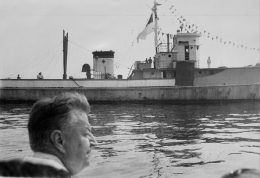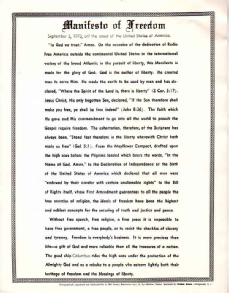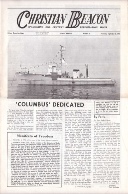© 2014-


Radio Free America - History
The background to the arrival of this offshore station off the Atlantic coast of the USA lay in a dispute over the complex Federal rules governing legal land-
Rev. Carl McIntire, then 67, was pastor of the Bible Presbyterian Church of Collingwood, New Jersey and owned two stations -
He had also run into trouble with the governing body of American broadcasting -
The FCC, frustrated by McIntire's continued flouting of the fairness rule decided to close both WXUR outlets on 5th July 1973, ostensibly for failing to keep regular station logs. Carl McIntire announced during the final programmes on WXUR that he would find a way of returning to the airwaves with a new station, which he would call Radio Free America, and promised to do so within two weeks.
In order to stay outside FCC control McIntire planned to use a ship anchored in international waters as a base for his new radio station, but instead of the anticipated two weeks it took him six weeks to find and equip a suitable vessel.
Having announced his plans, McIntire began a game of cat and mouse with the authorities. When he lined up a suitable ship for his station, a 160-
The ship eventually a cquired by McIntire was the MV Oceanic, a former minesweeper which had also latterly been used by oceanographer Jacques Cousteau as a base for scuba diving off Cape Canaveral in Florida. The vessel was leased by McIntire and re-
cquired by McIntire was the MV Oceanic, a former minesweeper which had also latterly been used by oceanographer Jacques Cousteau as a base for scuba diving off Cape Canaveral in Florida. The vessel was leased by McIntire and re-
First transmission
Radio Free America had its landbased headquarters in Carl McIntire's "Christian  Admiral" Hotel at Cape May, New Jersey. McIntire proposed to give listeners to his new station a demonstration of free speech "as the Founding Fathers had intended it." Some broadcasts, including news bulletins, were to be transmitted live from the MV Columbus, with guest speakers being taken out to the radio ship, while other programmes would be pre-
Admiral" Hotel at Cape May, New Jersey. McIntire proposed to give listeners to his new station a demonstration of free speech "as the Founding Fathers had intended it." Some broadcasts, including news bulletins, were to be transmitted live from the MV Columbus, with guest speakers being taken out to the radio ship, while other programmes would be pre-
A test carrier signal was transmitted from the Columbus on 1160kHz (259m) shortly before midnight (EST) on 12th September 1973. Then just after 1.30am the following morning the first music was broadcast from Radio Free America. However, this test transmission only lasted half an hour due to technical problems with equipment which ultimately resulted in a small fire breaking out in the control room and on the wooden deck of the Columbus.
The following day, 14th September 1973 the ship broke from her anchor and was forced to enter port for repairs and to have a new anchor installed. Some work was completed, although the new anchor could not be fitted immediately, but nevertheless the Columbus left port at 7.00pm on 15th September and sailed into international waters along the New Jersey coast. Radio Free America made a further four hour test broadcast while the ship was sailing up and down the coastline during the early morning of 16th September 1973. Later that same day the ship entered port to have her new anchor fitted and three days later she was back at sea again transmitting programmes for Radio Free America.


Click on picture to enlarge

Record and Radio Mirror
29th September 1973
The ‘Manifesto of Freedom’ setting out the reasons for the establishment of Radio Free America.
Click to enlarge

Christian Beacon
6th September 1973

History
Key Dates
Ship and Location
Technical
Staff




Rev Carl McIntire with the Columbus

Billboard
29th September 1973

Back to Radio Free America


Back to America Gallery